
(a)
Interpretation: The product of the given reaction is to be drawn including stereochemistry if appropriate.
Concept introduction: Alkyl tosylates undergo elimination reaction when they are allowed to react with strong nucleophilic base. The mechanism of the elimination reaction is
Answer to Problem 9.69P
The product of the given reaction is,

Figure 2
Explanation of Solution
The given reaction involves treatment of alkyl tosylate with
Alkyl tosylates undergo elimination reaction when they are allowed to react with strong nucleophilic base. The mechanism of the reaction is
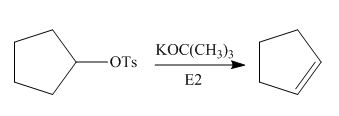
Figure 1
Thus, the product of the given reaction is,

Figure 2
The product of the given reaction is drawn in Figure 2.
(b)
Interpretation: The product of the given reaction is to be drawn including stereochemistry if appropriate.
Concept introduction: The reaction of alcohols with halogen acids
Answer to Problem 9.69P
The product of the given reaction is,

Figure 4
Explanation of Solution
The given reaction involves treatment of an alcohol with
The reaction of alcohols with halogen acids
The corresponding reaction is shown below.

Figure 3
Thus, the product of the given reaction is,

Figure 4
The product of the given reaction is drawn in Figure 4.
(c)
Interpretation: The product of the given reaction is to be drawn including stereochemistry if appropriate.
Concept introduction: Thiols react with
Answer to Problem 9.69P
The product of the given reaction is,
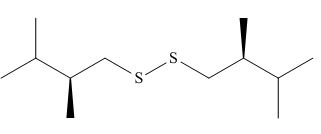
Figure 6
Explanation of Solution
The given reaction involves treatment of thiol with
Thiols react with
The corresponding reaction is shown below.

Figure 5
Thus, the product of the given reaction is,

Figure 6
The product of the given reaction is drawn in Figure 6.
(d)
Interpretation: The product of the given reaction is to be drawn including stereochemistry if appropriate.
Concept introduction: The
Answer to Problem 9.69P
The product of the given reaction is,
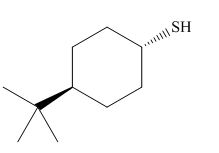
Figure 8
Explanation of Solution
The given reaction involves treatment of alkyl tosylate with
The

Figure 7
Thus, the product of the given reaction is,

Figure 8
The product of the given reaction is drawn in Figure 8.
(e)
Interpretation: The product of the given reaction is to be drawn including stereochemistry if appropriate.
Concept introduction: Alkyl bromides are obtained by the reaction of
Answer to Problem 9.69P
The product of the given reaction is,
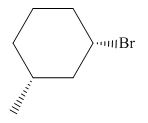
Figure 10
Explanation of Solution
The given reaction involves treatment of secondary alcohol with
Alkyl bromides are obtained by the reaction of

Figure 9
Thus, the product of the given reaction is,

Figure 10
The product of the given reaction is drawn in Figure 10.
(f)
Interpretation: The product of the given reaction is to be drawn including stereochemistry if appropriate.
Concept introduction: Alcohols are converted into alkyl tosylates by treatment with
Answer to Problem 9.69P
The product of the given reaction is,
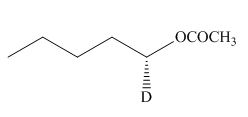
Figure 12
Explanation of Solution
The given reaction involves treatment of an alcohol with
Alcohols are converted into alkyl tosylates by treatment with
 Figure 11
Figure 11
Thus, the product of the given reaction is,

Figure 12
The product of the given reaction is drawn in Figure 12.
(g)
Interpretation: The product of the given reaction is to be drawn including stereochemistry if appropriate.
Concept introduction: The opening of an
Answer to Problem 9.69P
The product of the given reaction is,
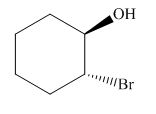
Figure 14
Explanation of Solution
The give reaction involves treatment of an epoxide with halogen acid
The opening of an epoxide/ethylene oxide ring is regioselective either it takes place with a strong nucleophile
The corresponding reaction is shown below.

Figure 13
Thus, the product of the given reaction is,

Figure 14
The product of the given reaction is drawn in Figure 14.
(h)
Interpretation: The product of the given reaction is to be drawn including stereochemistry if appropriate.
Concept introduction: The opening of an epoxide/ethylene oxide ring is regioselective either it takes place with a strong nucleophile
Answer to Problem 9.69P
The product of the given reaction is,
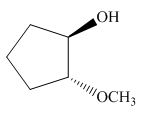
Figure 16
Explanation of Solution
The give reaction involves treatment of an epoxide with
The opening of an epoxide/ethylene oxide ring is regioselective either it takes place with a strong nucleophile
The corresponding reaction is shown below.

Figure 15
Thus, the product of the given reaction is,

Figure 16
The product of the given reaction is drawn in Figure 16.
(i)
Interpretation: The product of the given reaction is to be drawn including stereochemistry if appropriate.
Concept introduction: Ethers are the most common organic products of nucleophilic substitution reaction. They are prepared from alkyl halides and strong nucleophiles. The reaction proceeds through
Answer to Problem 9.69P
The product of the given reaction is,
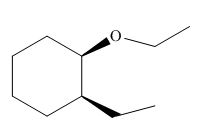
Figure 18
Explanation of Solution
The given reaction involves treatment of a
The alkoxide salts are prepared from alcohols through the Bronsted-Lowry acid-base reaction. In this reaction,
The obtained alkoxide from this reaction contains
The corresponding reaction is shown below.

Figure 17
Thus, the product of the given reaction is,

Figure 18
The product of the given reaction is drawn in Figure 18.
(j)
Interpretation: The product of the given reaction is to be drawn including stereochemistry if appropriate.
Concept introduction: Ethers react with strong acids, (only
In this reaction, both
Answer to Problem 9.69P
The product of the given reaction is,

Figure 20
Explanation of Solution
The given reaction involves treatment of an ether with two equivalents of
Ethers react with strong acids, (only
In this reaction, both
The corresponding reaction is shown below.

Figure 19
Thus, the product of the given reaction is,

Figure 20
The product of the given reaction is drawn in Figure 20.
(k)
Interpretation: The product of the given reaction is to be drawn including stereochemistry if appropriate.
Concept introduction: Sulfides are prepared from thiols by the successive treatment of sodium hydride (a good base), and an alkyl halide. The mechanism of the reaction is
Answer to Problem 9.69P
The product of the given reaction is,
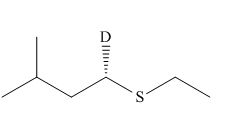
Figure 22
Explanation of Solution
The given reaction involves treatment of an alkyl halide with
The corresponding reaction is shown below.

Figure 21
Thus, the product of the given reaction is,

Figure 22
The product of the given reaction is drawn in Figure 22.
(l)
Interpretation: The product of the given reaction is to be drawn including stereochemistry if appropriate.
Concept introduction: Sulfide involves a nucleophilic sulfur atom. It reacts rapidly with unhindered alkyl halide to form corresponding sulfonium ion. The mechanism of the reaction is
Answer to Problem 9.69P
The product of the given reaction is,

Figure 24
Explanation of Solution
The given reaction involves treatment of sulfide with an unhindered alkyl halide.
Sulfide involves a nucleophilic sulfur atom. It reacts rapidly with unhindered alkyl halide to form corresponding sulfonium ion. The mechanism of the reaction is
The corresponding reaction is shown below.

Figure 23
Thus, the product of the given reaction is,
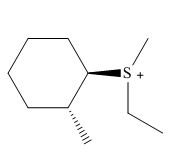
Figure 24
The product of the given reaction is drawn in Figure 24.
Want to see more full solutions like this?
Chapter 9 Solutions
ORGANIC CHEMISTRY
- What is the product of the reaction? F3C. CF3 OMe NaOH / H₂Oarrow_forwardWhat would you expect to be the major product obtained from the following reaction? Please explain what is happening here. Provide a detailed explanation and a drawing showing how the reaction occurs. The correct answer to this question is V.arrow_forwardPlease answer the question for the reactions, thank youarrow_forward
- What is the product of the following reaction? Please include a detailed explanation of what is happening in this question. Include a drawing showing how the reagent is reacting with the catalyst to produce the correct product. The correct answer is IV.arrow_forwardPlease complete the reactions, thank youarrow_forwardConsider the synthesis. What is compound Y? Please explain what is happening in this question. Provide a detailed explanation and a drawing to show how the compound Y creates the product. The correct answer is D.arrow_forward
- What would be the major product of the following reaction? Please include a detailed explanation of what is happening in this question. Include steps and a drawing to show this reaction proceeds and how the final product is formed. The correct answer is B. I put answer D and I don't really understand what is going on in the question.arrow_forwardWhat is the product of the following reaction? Please explain what is happening in this question. Provide a detailed explanation and a drawing showing how the reagent is reacting with the catalysts to product the correct product. The correct answer is B.arrow_forwardWhat is the missing intermediate 1 and the final product 2. Please include a detailed explanation explaining the steps of malonic ester synthesis. Please include drawings of the intermediate and how it occurs and how the final product is former.arrow_forward
 ChemistryChemistryISBN:9781305957404Author:Steven S. Zumdahl, Susan A. Zumdahl, Donald J. DeCostePublisher:Cengage Learning
ChemistryChemistryISBN:9781305957404Author:Steven S. Zumdahl, Susan A. Zumdahl, Donald J. DeCostePublisher:Cengage Learning ChemistryChemistryISBN:9781259911156Author:Raymond Chang Dr., Jason Overby ProfessorPublisher:McGraw-Hill Education
ChemistryChemistryISBN:9781259911156Author:Raymond Chang Dr., Jason Overby ProfessorPublisher:McGraw-Hill Education Principles of Instrumental AnalysisChemistryISBN:9781305577213Author:Douglas A. Skoog, F. James Holler, Stanley R. CrouchPublisher:Cengage Learning
Principles of Instrumental AnalysisChemistryISBN:9781305577213Author:Douglas A. Skoog, F. James Holler, Stanley R. CrouchPublisher:Cengage Learning Organic ChemistryChemistryISBN:9780078021558Author:Janice Gorzynski Smith Dr.Publisher:McGraw-Hill Education
Organic ChemistryChemistryISBN:9780078021558Author:Janice Gorzynski Smith Dr.Publisher:McGraw-Hill Education Chemistry: Principles and ReactionsChemistryISBN:9781305079373Author:William L. Masterton, Cecile N. HurleyPublisher:Cengage Learning
Chemistry: Principles and ReactionsChemistryISBN:9781305079373Author:William L. Masterton, Cecile N. HurleyPublisher:Cengage Learning Elementary Principles of Chemical Processes, Bind...ChemistryISBN:9781118431221Author:Richard M. Felder, Ronald W. Rousseau, Lisa G. BullardPublisher:WILEY
Elementary Principles of Chemical Processes, Bind...ChemistryISBN:9781118431221Author:Richard M. Felder, Ronald W. Rousseau, Lisa G. BullardPublisher:WILEY





